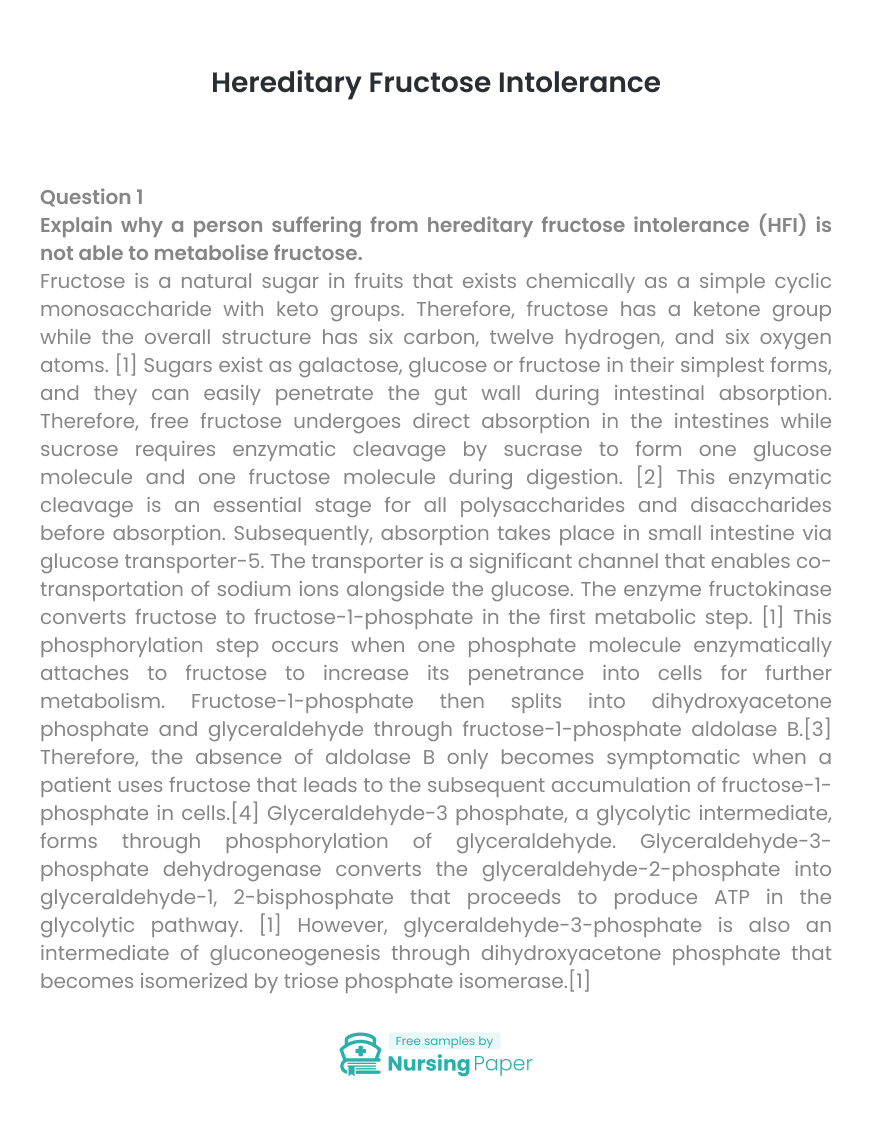
Hereditary Fructose Intolerance
Question 1
Explain why a person suffering from hereditary fructose intolerance (HFI) is not able to metabolise fructose.
Fructose is a natural sugar in fruits that exists chemically as a simple cyclic monosaccharide with keto groups. Therefore, fructose has a ketone group while the overall structure has six carbon, twelve hydrogen, and six oxygen atoms. [1] Sugars exist as galactose, glucose or fructose in their simplest forms, and they can easily penetrate the gut wall during intestinal absorption. Therefore, free fructose undergoes direct absorption in the intestines while sucrose requires enzymatic cleavage by sucrase to form one glucose molecule and one fructose molecule during digestion. [2] This enzymatic cleavage is an essential stage for all polysaccharides and disaccharides before absorption. Subsequently, absorption takes place in small intestine via glucose transporter-5. The transporter is a significant channel that enables co-transportation of sodium ions alongside the glucose. The enzyme fructokinase converts fructose to fructose-1-phosphate in the first metabolic step. [1] This phosphorylation step occurs when one phosphate molecule enzymatically attaches to fructose to increase its penetrance into cells for further metabolism. Fructose-1-phosphate then splits into dihydroxyacetone phosphate and glyceraldehyde through fructose-1-phosphate aldolase B.[3] Therefore, the absence of aldolase B only becomes symptomatic when a patient uses fructose that leads to the subsequent accumulation of fructose-1-phosphate in cells.[4] Glyceraldehyde-3 phosphate, a glycolytic intermediate, forms through phosphorylation of glyceraldehyde. Glyceraldehyde-3-phosphate dehydrogenase converts the glyceraldehyde-2-phosphate into glyceraldehyde-1, 2-bisphosphate that proceeds to produce ATP in the glycolytic pathway. [1] However, glyceraldehyde-3-phosphate is also an intermediate of gluconeogenesis through dihydroxyacetone phosphate that becomes isomerized by triose phosphate isomerase.[1] Alternatively, hexokinase can phosphorylate fructose to fructose-6-phosphate that enters directly into the glycolytic pathway to produce ATP.


The metabolic pathway of fructose provides a clear understanding of the consequences and presentations of hereditary fructose intolerance (HFI). HFI is a genetic metabolic disorder that results from the hereditary absence of aldolase B. [5, 6] The genetic disorders of metabolism are hereditary defects of enzymes in the metabolism of nutrients that reduces the capacity of the body to assimilate nutrients. Therefore, the absence of aldolase B-enzyme impairs the conversion of fructose-1-posphate to its products. [6] Consequently, fructose-1-phosphate accumulates in blood due to lack of aldose B for its conversion to dihydroxyacetone phosphate and glyceraldehyde. Moreover, blood measurements of fructose-1-phosphate will be high while dihydroxyacetone phosphate and glyceraldehyde will be low after consumption of fructose in HFI. The major symptoms of HFI are nausea, abdominal distress, vomiting, and failure to thrive.[7] These symptoms are due to the biochemical derangements resulting from the consumption of fructose.[7] For example, hypoglycemia will result from failure of the cells to complete fructose metabolism to release ATP.[8] The prevalence of fructose intolerance in the Australian population is 34%.[9] The interesting fact about HFI is the stride made in current research to establish oral mannose as a safe intervention for managing glycemic abnormalities in HFI.[10] Therefore, the input of dietitians is important to help HFI patients to complete a successful dietary planning that will replace all the sources of fructose with other sugars such as maltose and glucose. Since fructose is a constituent of sucrose, [1] the dietary planning should exclude sucrose from the diet.
1. Talwar GP. Textbook of biochemistry, biotechnology, allied and molecular medicine. Delhi: PHI Learning Pvt. Ltd.: 2015.
2. Klein AV, Kiat H. The mechanisms underlying fructose-induced hypertension: A review. Journal of Hypertension. 2015; 33(5):912-920. Available from doi: 10.1097/HJH.0000000000000551.
3. Feinman RD, Fine EJ. Fructose in perspective. Nutrition & Metabolism. 2013; 10(1): 45-51. Available from doi: 10.1186/1743-7075-10-45.
4. Nagornaya NV, Bordyugova YV, Dudchak АP, Koval АP. Hereditary Fructose Intolerance. Child’s Health. 2014: 3(54):92-6. Available from doi: 10.22141/2224-0551.3.54.2014.76039.
5. Ahmed N. Clinical biochemistry. Great Clarendon Street: Oxford University Press: 2016.
6. Fiocchi A, Dionisi-Vici C, Cotugno G, Koch P, Dahdah L. Fruit-induced FPIES masquerading as hereditary fructose intolerance. Pediatrics. 2014: 134(2): e602-5. Available from doi: 24594126.
7. Peter Baker II, Ayres L, Gaughan S, Weisfeld-Adams J. Hereditary fructose intolerance. [Review]. Available at: https://www.ncbi.nlm.nih.gov/books/NBK333439/.



The download will start shortly.

The download will start shortly.
 Subject:
Medicine
Subject:
Medicine  Number of pages: 5
Number of pages: 5  Subject:
Health and Social Care
Subject:
Health and Social Care  Number of pages: 3
Number of pages: 3  Subject:
Health and Social Care
Subject:
Health and Social Care  Number of pages: 4
Number of pages: 4  Subject:
Health and Social Care
Subject:
Health and Social Care  Number of pages: 10
Number of pages: 10  Subject:
Medicine
Subject:
Medicine  Number of pages: 3
Number of pages: 3  Subject:
Health and Social Care
Subject:
Health and Social Care  Number of pages: 7
Number of pages: 7  Subject:
Medicine
Subject:
Medicine  Number of pages: 3
Number of pages: 3  Subject:
Health and Social Care
Subject:
Health and Social Care  Number of pages: 2
Number of pages: 2  Subject:
Medicine
Subject:
Medicine  Number of pages: 4
Number of pages: 4  Subject:
Medicine
Subject:
Medicine  Number of pages: 11
Number of pages: 11  Subject:
Medicine
Subject:
Medicine  Number of pages: 2
Number of pages: 2  Subject:
Nursing
Subject:
Nursing  Number of pages: 3
Number of pages: 3  Subject:
Medicine
Subject:
Medicine  Number of pages: 4
Number of pages: 4  Subject:
Health and Social Care
Subject:
Health and Social Care  Number of pages: 9
Number of pages: 9  Subject:
Health and Social Care
Subject:
Health and Social Care  Number of pages: 6
Number of pages: 6 
